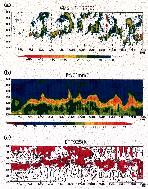 | Fig. 1. Map of Kyushu Islands and observation instruments during the TREX period. |
M. Yoshizaki, H. Sakakibara, and Members of MRI-TREX
Meteorological Research Institute/Japan Meteorological Agency
1-1, Nagamine, Tsukuba, Ibaraki, Japan 305
TREX, which was organized by Prof. T. Takahashi, was made by JMA, MRI, national institutes and universities during the period from middle June to early July 1996. Figure 1 shows locations of observation instruments and period. JMA made special upper sounding observations at Fukuoka, Kagoshima, Naze, V(Vessel)-Chofu and V-Keifu, and also special radar observations at Fukuoka, Tanegashima, Naze and V-Keifu. MRI made Doppler radar observation at Yakushima and, upper sounding and microwave radiometer observations at Tairajima. Here we want to introduce activities of MRI group. General reviews of TREX should be referred to in Takahashi (1997).
 | Fig. 1. Map of Kyushu Islands and observation instruments during the TREX period. |
JMA GANAL (Global Analysis) data of every 6 hour were used. Figure 2 shows time-averaged horizontal distributions of heights and wind at several levels (Bessho and Eito 1997). Pacific high and thermal low over the Asian continent due to the contrast of sea-land-mountain (Tibetan Plateau) are essential to determine general large-scale features. In the lower troposphere, southwesterly wind on the northern side of East China Sea and Kyushu Islands was dominant. In the middle troposphere (700hPa) splitted flows was seen around the Tibetan Plateau and converged over the East China Sea. The westerly jet flow was found around 35N-40N in the upper troposphere.
 | Fig. 2. Time-averaged horizontal distributions of heights and wind at several levels (Bessho and Eito 1997). |
Temperature near the surface varied in the east-west direction over the East China Sea, while it changed rather in the north-south direction on the eastern side of Kyushu Islands. In middle and upper troposphere, warm areas over the Tibetan Plateau due to the diabatic heating were noticed and baroclinicity of temperature in the north-south direction was found around 35N, where the cyclones frequently developed.
For the moisture fields, the low latitude regions are moist near the surface, and so the north-south gradient is large. However, at 700hPa and above, the moist tongue, which is the Baiu front, was remarkable over the East China Sea. The air advected from around the Tibetan Plateau was moist, because the monsoon and convective activities there were very active, while both Pacific high region due to subsidence and northwestern land region were very dry. The moist tongue was seen even in the precipitable water content - vertically integrated moisture.
In and along the Baiu front the stratification is nearly neutral. Meanwhile the stratification in the Pacific high region was convectively unstable. Therefore, cloud clusters developed actively, when the intense southwesterly flew into the Baiu front.
(b) Synoptic-scale disturbances
When temporal variations of synoptic scale disturbances were examined, roughly speaking, there were the repetition of two phases (Fig. 3). One is the development stage of extratropical cyclones on the northern side of Japan. The second phase is the dominance of quasi-stationary fronts after the cyclones.
 | Fig. 3. Time-latitude sections of GMS-IR TBB, precipitable water content and equivalent potential temperature at 925hPa along 130E (Bessho and Eito 1997). |
(c) Cloud clusters
Cloud clusters frequently occurred along the Baiu front. One example on 7 July 1996 is shown in Fig.4a (Seko et al. 1997). In the cloud cluster, MCSs extended in the east-west direction (Fig.4b). To study structures and formation mechanisms of the MCSs, the MRI nonhydrostatic model of 10km horizontal resolution (MRI-NHM) was applied to simulate them. Simulated MCSs (Figs.4c and 4d) were similar to observed ones. It is suggested from sensitivity experiments that the large-scale advection of high equivalent potential temperature in the lower atmosphere is important for the formation and development of MCSs.
(d) Diurnal variation of precipitation
Kurihara and Kato (1997) examined temporal variations of rainfall activity by using Radar-AMeDAS data, and found a remarkable diurnal variation around Kyushu Islands.
In the X-BAIU project, rawinsonde observations (four times per day) of four JMA vessels and six JMA operational upper sounding sites for 10 days during June and July 1998 will be made over the East China Sea and Kyushu Islands. At the same time, special observations of upper sounding, Doppler radar, boundary-layer radar, microwave radiometer and GPS at one station on the western Kyushu with cooperation of universities, and airborne Doppler radar observations will be done, although these latter plans are not fixed. Comparison of TRMM precipitation data with radar and surface observation data, and estimation of diabatic heating by TRMM data are also aimed.
Bessho, K., and H. Eito, 1997: Environment of Baiu front in the TREX period. Proc., Spring Meeting, Japanese Meteor. Soc., 71, G221 (in Japanese).
Ishihara, M., Y. Fujiyoshi, A. Tabata, H. Sakikibara, K. Akaeda and H. Okamura, 1995: Dual Doppler radar analysis of an intense mesoscale rainband generated along the Baiu front in 1988. J. Meteor. Soc. Japan, 73, 139-163.
Japan Meteorological Agency, 1974: Report on the severe rainstorms in Japan. Tech. Reports of JMA, 86, 454pp.
Kurihara, K. and T. Kato, 1997: Characteristics of diurnal variation of precipitation around Kyushu district during the Baiu season. Accepted by Tenki.
Ninomiya, K., 1980: Heavy rainfalls in the Baiu frontal zone. Meteor. Res. Note, 277pp (in Japanese).
Seko, H., T. Kato, K. Saito, K. Kurihara, M .Yosizaki, H. Goda and MRI-TREX group, 1997: Precipitation system observed in TREX (7 July 1997). Proc., Spring Meeting, Japanese Meteor. Soc., 71, A103 (in Japanese).
Takahashi, T., 1997: Report of TREX. Submitted to Tenki (in Japanese).